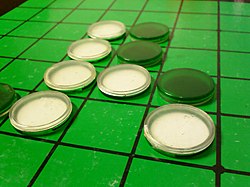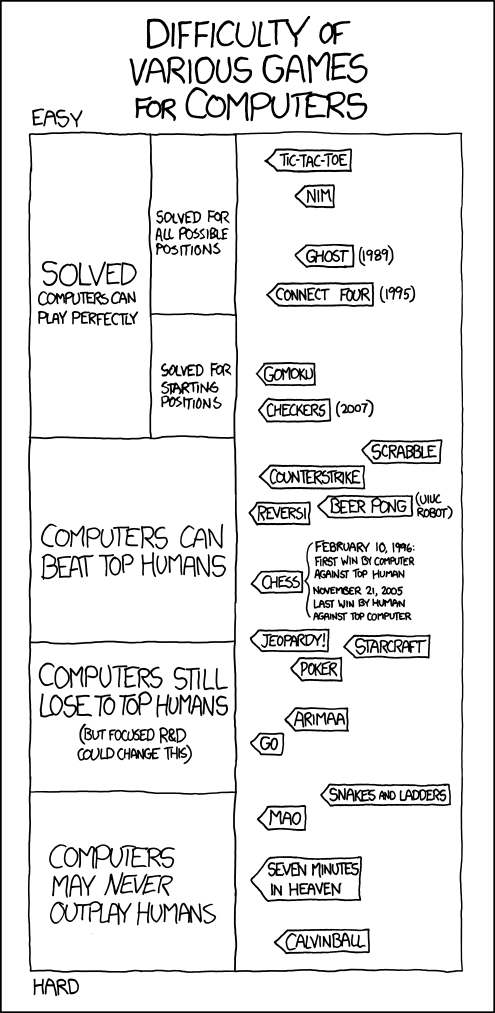I thought I’d find a wealth of information on the net about how to program a Reversi game. However, there wasn’t all that much out there. I found some helpful blog entries at Red Alt Blog. I used that as my starting point.
The best resource for understanding how to program Reversi is at the chess programming wiki. They have an Othello page as well as pages that helped me do a bitboard version of Reversi, with move generation and resolution (dumb7fill), population count (i.e., number of bits on the board) and board serialisation (using bitscans). I'm hoping it'll also be helpful for position evaluation later on.
The tasks needed to code a Reversi computer game with a learning computer opponent are
- Game state representation
- Move generation
- Move resolution
- Determine game over and winner
- Graphic User Interface
- Save/load and undo/redo moves
- Position evaluation (i.e., fitness/objective function)
- Depth-first search algorithm (e.g., mini-max or nega-scout)
- Book/database based analysis (e.g., opening book, transposition tables)
- Mathematical optimisation (e.g., simulated annealing or genetic algorithm)
The following sections describe some interesting parts of the source code, relating with the first six steps outlined above.
Reading the source code
The entry point for the application (the Main method) is the Start method of the GameBehaviour.cs file. This file is attached to the main camera in Unity. The GameBehaviour.cs file creates the board and pieces as 3D objects and hosts an instance of GameManager (see below). It also manages the UI controls to save/load games, undo/redo moves, setup the human/computer players, start a new game, etc.
The files that do all the real work are:
- GameBehaviou.cs
- GameManager.cs
- GameState.cs
- BitBoardHelper.cs
- Play.cs
GameManager
The GameManager class does the work-a-day tasks of the game. Tasks such as:
- Save/load
- Undo/redo
- Tells you whose turn it is
- Tracks the list of plays
- Tracks the turn number
My GameState class handles most of the game rules of a Reversi game. You pass it two unsigned 64-bit integers (ulong in C#). These numbers are a bitboard representation of the game. The first number represents the current player's pieces. The second number represents the opponent's pieces. E.g., the starting position for black is represented as 0000000000000000000000000001000000001000000000000000000000000000 in binary. When you lay out those zeros and ones on an Reversi board, you get:
Why represent the pieces like this? Bitboards appear to have advantages over other board representations. They appealed to me because I often feel withdrawn from the goings on of the computer. Bitboards were a chance to get in closer to the CPU and play around with individual bits.
One interesting aspect of the GameState class is that it is temporally agnostic. It doesn't know what turn of the game it is. It doesn't even know whose colour is to play next. All it cares about is that it is someone's turn and it figures out where they can play and what happens to the board once they do. I like the simplicity of not needing to deal with time.
The GameState class will tell you if the game is over and whether the current player has won.
BitBoardHelper
I created a BitBoardHelper class to add some extension methods to my ulong bitboards. These methods allow me to count the number of bits, find the indices of the bits and find the unoccupied bits of any two bitboards. I'll probably expand this class when I work on the computer opponent.
For finding the indices (bitboard serialisation) I used the De Bruijn method to do the bitscanning. For the bit count (population count) I used the SWAR Popcount routine.
Play
There is a Play class in the project that will find all the valid moves for the current player and also resolve a chosen move (i.e., flip of the pieces that need to flipped once a piece has been played). The basic idea is to focus one direction (cardinal or ordinal) at a time, scanning 8 locations in parallel. Red Alt explains it well (see under the bitboard heading). Once I could detect where a player could place a piece, I used a very similar method to resolve that move. This class is called by the GameState class and is only different to the BitBoardHelper class in that it has specifically Reversi functionality.
Graphic User Interface
The GUI uses the Unity 3D graphics engine. Much of the code that I use in the Reversi project is a simpler version to what is found in a previous article on Unity and path-finding. Unity displays the board and captures user input.
Save/load games and undo/redo moves
Save/load and undo/redo are interrelated. To do them, I need to keep track of the moves made by the players. If I do that, I can:
- Save: Write the move list to the hard drive.
- Load: Read the move list from the hard drive, start a new game, apply move list - one move at a time - until the last move is applied.
- Undo: Start a new game, apply move list until the desired turn (similar to load).
- Redo: Identical to undo.
In Part 2, I intend to cover the aspects of creating a computer opponent for Reversi. The primary goal is to be able create an opponent that can beat me in a game. (Not a highly goal.) Hopefully, I'll be able to have it beat all but the best Reversi players.











